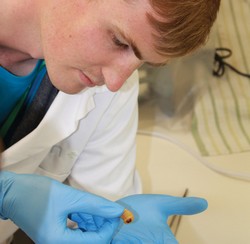Raising healthy pests will gain insight into their behaviour

Technical Assistant Andrew Pugh with Prionoplus reticularis larva (huhu grub).
Our entomologists are working with Plant and Food Research to rear common wood and bark eating pests in the laboratory in order to gain a better understanding of their seasonal breeding cycles. This will help us define the start-finish times of a non-fumigation period for log exports, when the risk of pest infestation is low. Having a collection of healthy pests available will also support the development and testing of new phytosanitary treatments as alternatives to methyl bromide.
“We have successfully reared both the golden-haired bark beetle (Hylurgus ligniperda) and the burnt pine longhorn beetle (Arhopalus ferus) in the laboratory through a complete generation, and been able to induce egg-laying,” says entomologist Dr Cecilia Romo.
“The insects were fed on an artificial diet and kept at a constant 25°C temperature in incubators, which increased their rate of development by about 50 per cent compared to those in the wild. The burnt pine longhorn beetles grew from newly hatched larva to adult in as few as 73 days, whereas in the wild, this takes a year.”
A large number of black pine bark beetles, Hylastes ater, have also been collected in a collaborative trapping exercise between the two organisations for fumigation testing and to further investigate artificial rearing technologies and diet.
For further information:
Contact Dr Cecilia Romo at Show email
